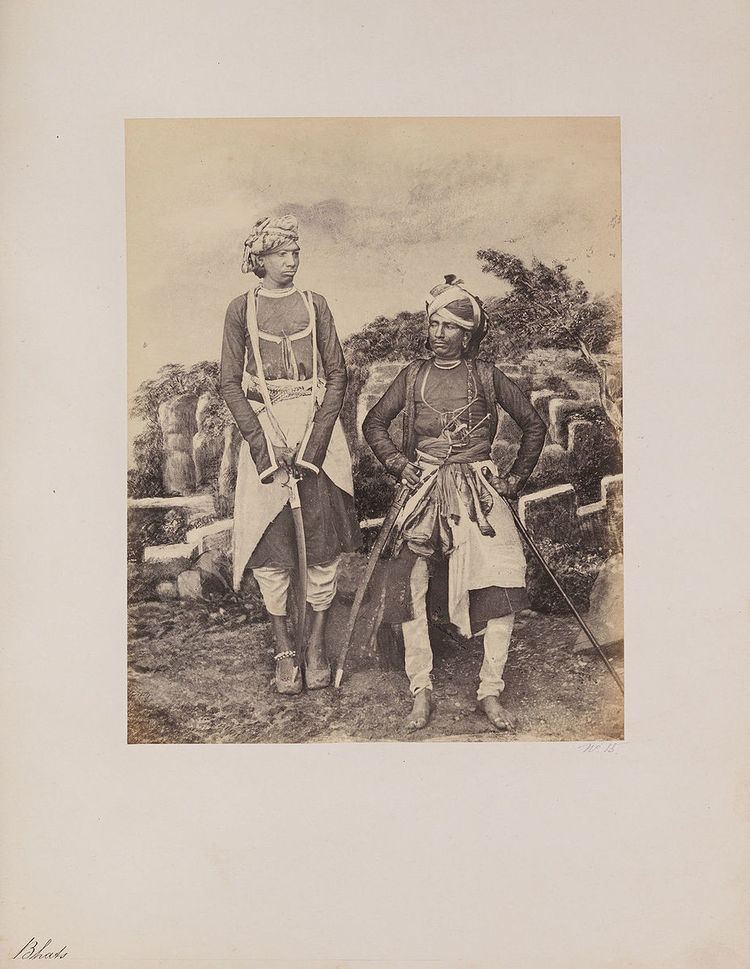 | ||
Bhat (Hindustani: भट , بھٹ ), also spelled as Butt (Pahari: بٹ), both of which are a shortened rendition of Bhatta, also spelled Bhatt, (Hindustani: भट्ट , بھٹّ ), is a common surname in India and Pakistan.
Contents
Etymology
Historians state the surname is a distorted form of Bhatta, which originates from Sanskrit (भटट), meaning "scholar" according to the Brāhmaṇa. While the original shortened rendition of "Bhatta" was "Bhat" or "Bhatt," many of the migrants to the Punjab region started spelling their surname as "But" or "Butt" which is the spelling of the clan used in the Pahari language.
Deccan
The Bhatt of South India were said to be invited there King Pratapa Rudra of the Kshatriya dynasty of Warangal (1295 to 1323) After the fall of this dynasty, the Bhatraju became court bards and entertainers for a number of Vellama and Reddi chiefs who had carved out small principalities for themselves in the Telegu country. The Bhatraju are now a Telugu speaking community.
Goa
The surname is in use among some Konkani Christians who trace their ancestry to the Goud Saraswat Brahmins of Goa.
Karnataka
This is a common surname among Goud Saraswat Brahmins and Havyaka Brahmins of Karnataka.
Kashmir
Bhat, also spelled as Butt, is a Kashmiri surname, found among individuals native to the Kashmir Valley of India, as well as Kashmiri émigrés who have migrated to the Punjab, a region divided between India and neighbouring Pakistan. A large number of Muslim Kashmiris migrated from the Kashmir Valley to the Punjab due to conditions in the princely state such as famine, extreme poverty and harsh treatment, by the Dogra Hindu regime, which Kashmiri Muslims faced because of their religion. Kashmiris bearing the surname Bhat/Butt belong to the larger Bhat caste of Brahmins found in the rest of the India; the surname is shared by both Hindus and Muslims.
Punjab
Some Muslim Bhats/Butts found in the Punjab migrated from Kashmir and Jammu during the 1878 famine, and are Brahmin Hindu converts to Islam.
In areas such as the Punjab region most of the Northern Hindu Saraswat Brahmins and some various other northern Hindu castes, such as Rajputs converted to the Sikh Bhat/Bhatra sangat during the missionary efforts of prince Changa Bhat Rai who earned the title "Bhat Rai", who was the grandson of Raja Shivnabh, a Hindu king who had met Guru Nanak and converted to Sikhism during the 16th century. During the 14th to 16th century many Saraswat Brahmins were forced to lead unsettled lives due to religious oppression, unable to practice their hereditary profession as Hindu priests, artists, teachers, scribes, technicians class (varna). They used their academia in there unsettled life travelling as scribes, genealogies, bards and astrologists. In the 15th century the religion of Sikhism was born causing many to follow the word of Guru Nanak Dev. The Sikhs also share the Bhat heritage, and are known as the Bhat or Bhatra and Bhatta sangat and were amongst the first followers of Guru Nanak. Even though Sikhism itself does not support separation by caste, the social system meant that the Bhatra followed a hereditary profession of travelling missionaries, scribes, genealogies, bards astrologists and itinerant salesman; however it is not uncommon to see Bhats in other professions such as farming and retail.
